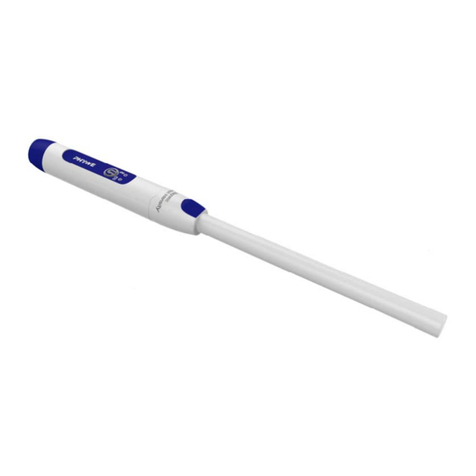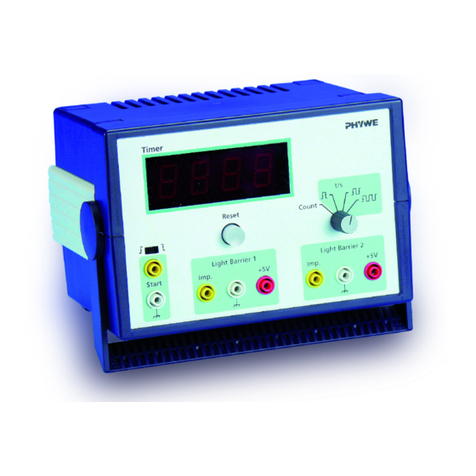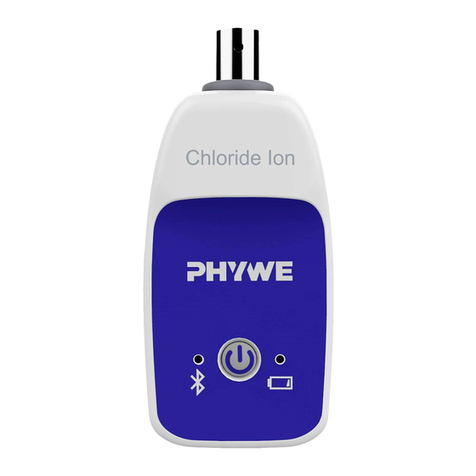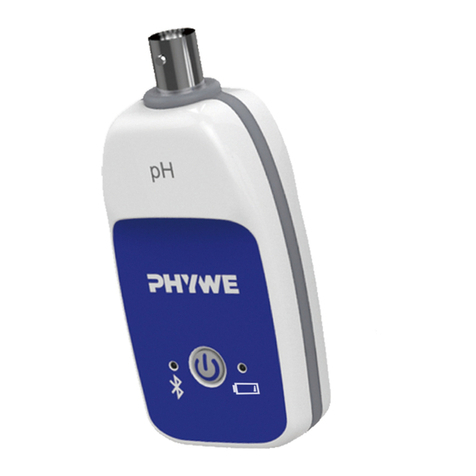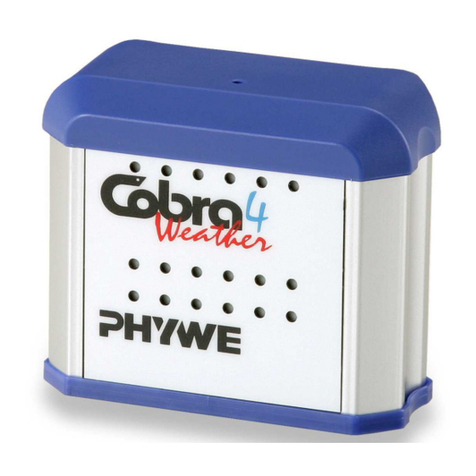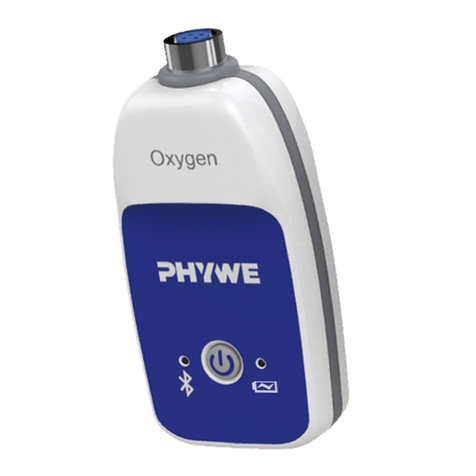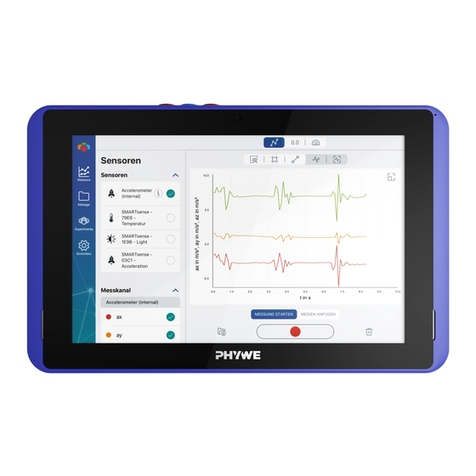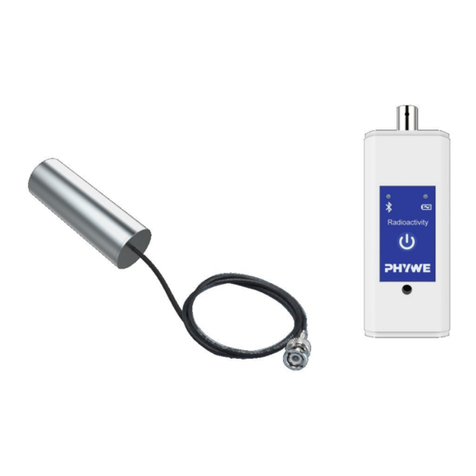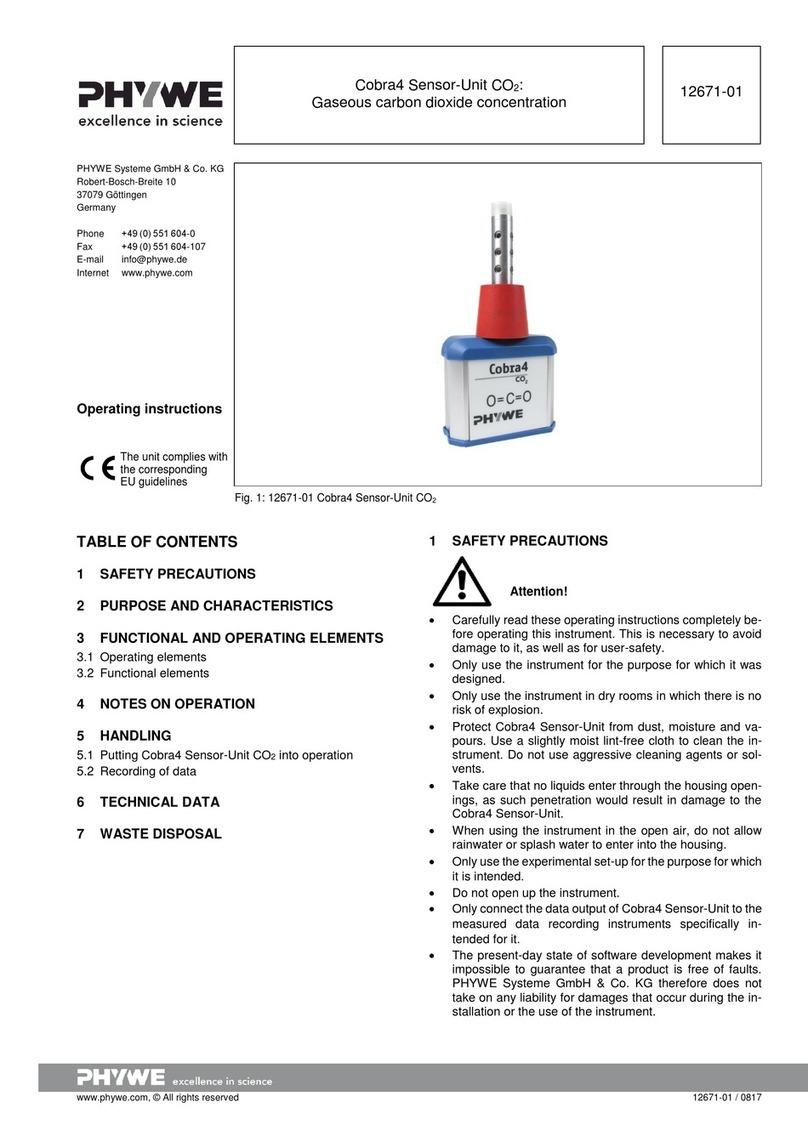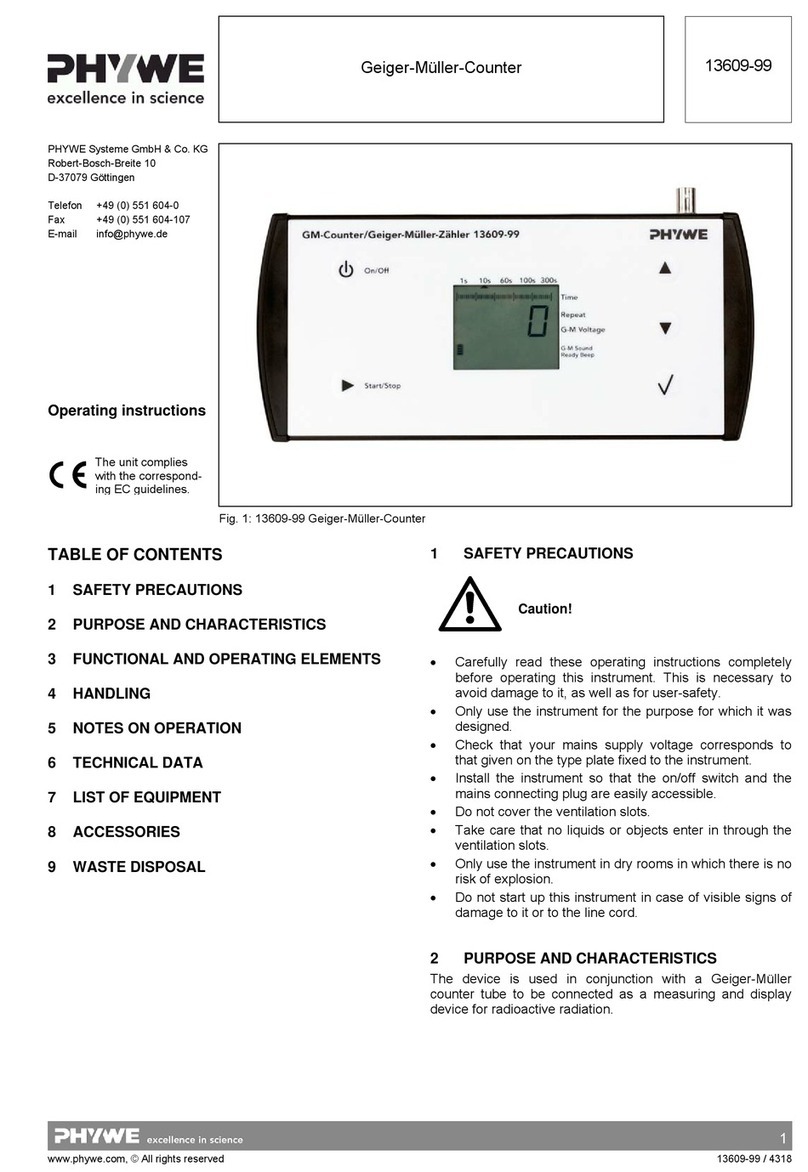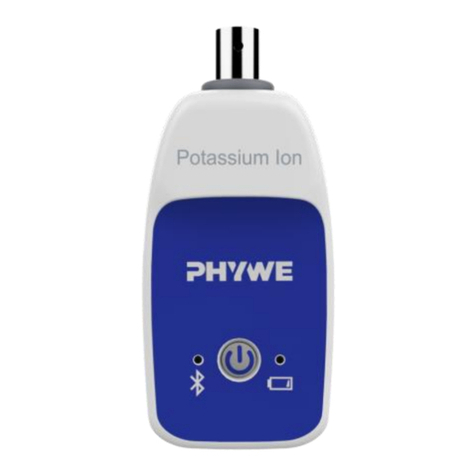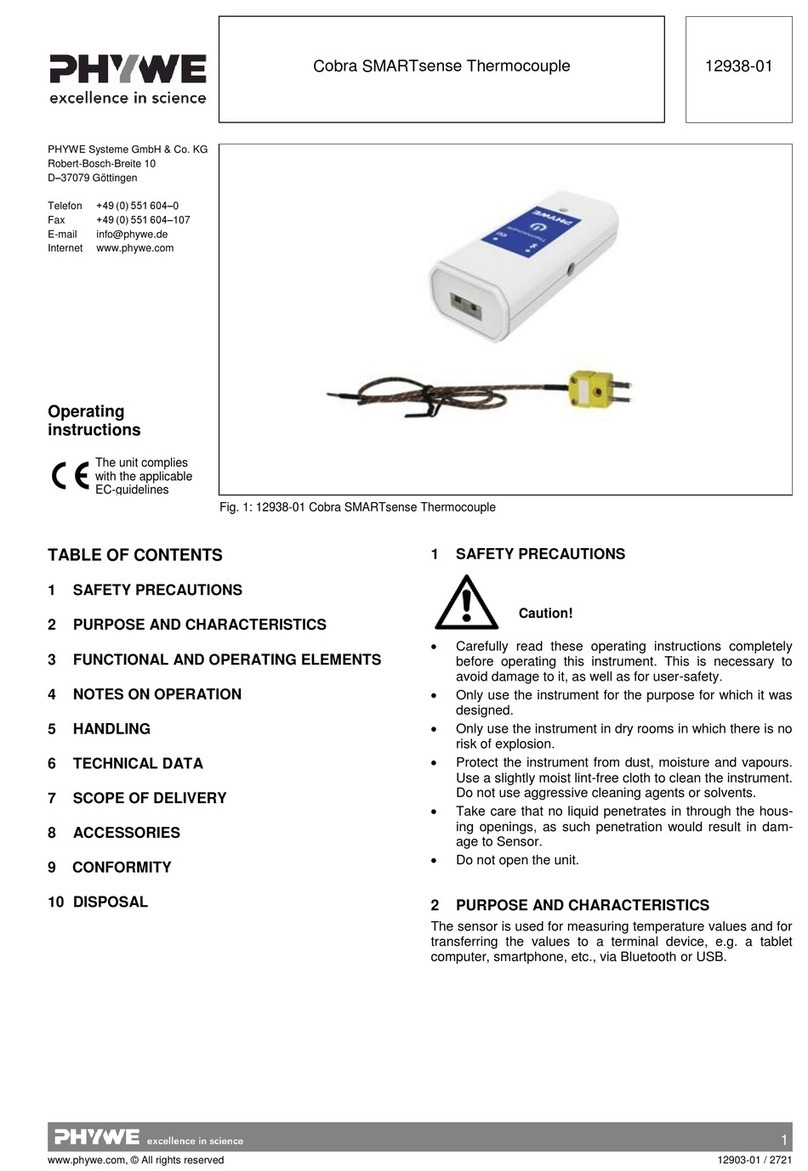4 HANDLING
4.1 Starting up
A smoothed, floating DC supply voltage between 14 and
18V is to be applied to the socket pair 5, with the correct
polarity. The voltage source must be capable of being
loaded up to 200 mA; universal power supply 13500.93 or
double power supply 13520.93 are suitable. The necessary
earth contact of the EFM is conveniently connected to the
4 mm transverser hole in the housing stem. This hole can
also be used to tighten the screw fastening of the stem with
the aid of a spanner or the like.
Any continuous voltmeter of adequate measurement range
is to be connected to output 3. Output voltage increases
linearly with field intensity. Depending on the direction of the
field, it will reach +10 V or -10 V for the selected final value
of the measurement range. As an optimal solution for
demonstration purposes, we recommend Analogue-Demo
Multimeter ADM 2, 13820.00 with ±10 V- measurement
range and zero in the centre of the scale. The sign of the
pointer deflection indicates the direction of the field at the
measuring electrode: provided the moving coil instrument is
connected to output 2with the correct polarity, a positive
deflection denotes a field towards the measuring electrode,
or a positive potential with respect to equipment earth of the
capacitor plate of the voltage adapter.
Attention: when the unit is switched on, no intense field
must act on the measuring head, because this would
disturb the automatic function test. Please cover the
measuring head with the protective cap 8.1 before
switching on the unit, or, in case the voltage measuring
head 10 is used, short input 11. After switching on, the unit
is ready for work as soon as the luminous diodes for the
range display stop flashing. If flashing does not stop after a
few seconds, this shows the function test was disturbed by
electric fields. In this case, briefly switch off power supply
and switch it on again once the measuring head is free of
electric fields.
4.2 Electrical zero adjustment
Before making the measurement, electrical zero adjustment
has still to be carried out, because even if no electric field is
acting on the measuring electrode of the instrument, the
pointer of the moving-coil instrument can deviate from the
set mechanical zero-point (scale centre). The appropriate
correction of the pointer position can be carried out with the
aid of the rotary knob 2of the EFM, and most accurately
when the most sensitive measuring range is set by the
push-button 6. Naturally, the zero adjustment must be
carried out in the absence of the field to be measured.
It should be noted that, in addition to the measurement field,
stray electrostatic fields caused by charged parts in the
vicinity will sometimes affect the measuring head. It is true
that these fields can easily be screened off by means of the
protective cap 8.1 for adjustment purposes, but during the
actual measurement (without the cap), they would again be
effective. The existence of interference fields can be
recognised from the fact that the pointer deflections differ
considerably with and without the protective cap. As far as
possible, stray electrostatic fields should be avoided. A
slight residual field can be eliminated from the measured
result by the electrical zero adjustment.
A further factor influencing the measurement is the voltaic
potential between the measuring electrode and measuring
apparatus (environment). Of course, its field only becomes
significant when working in the most sensitive measuring
range. It can be eliminated if the electrical zero adjustment
is carried out in the experimental jig itself, which must of
course be in a discharged condition. Practical examples:
For electrostatic voltage measurements, the zero
adjustment is carried out with the voltage adapter 10
attached and short-circuited with a connection lead. In the
case of field strength measurements in a plate capacitor
similar to the calibration apparatus, with the measuring
head inserted in the hole in one plate (Fig. 2), the zero
adjustment is carried out with the capacitor plates short-
circuited.
With relatively open measuring arrangements, where the
measuring head is not screened from stray fields from the
surroundings, the pointer deflection will also be influenced
by the operator himself e.g. when operating the rotary
knob 2; therefore one should move sufficiently far away
from the EFM in order to read the pointer position. This
applies both to the zero adjustment and the actual
measurement.
The zero drift of the EFM is relatively small and can be
practically disregarded over the time of performance of an
experiment. However, when working with an open
experimental arrangement, it should be expected that stray
electrostatic fields will vary in an uncontrolled manner or
even come into being in the course of the experiment. It is
therefore advisable to repeat the zero check from time to
time.
4.3 Treatment of the measuring system
The gold-plated measuring system (and also the capacitor
plate of the voltage adapter) should not be contaminated
and also should not be touched by hand. Above all, the
rotating chopper wheel must not be touched. For an
inexperienced observer, the rotation is not directly visible or
audible. The Teflon insultation of the voltage adapter should
also not be touched or contaminated, so that no conductive
surfaces are formed. When not in use, the sensitive
measuring system is to be covered with the protective cap
unless the voltage adapter is fitted.
4.4 Hints for working with the EFM
The EFM will be set up according to the particular
experimental requirements. The surface of the measuring
electrode should be arranged perpendicular to the direction
of the field to be investigated.
Unsatisfactory results in electrostatic experiments are
mainly due, apart from inadequate insulation of stems and
supports, to stray electrostatic fields They can be caused
not only by charged bodies which do not belong to the
actual measurement arrangement (e.g. high-voltage
sources), but also by uncontrollable charges on insulating
plastic surfaces. A few hints on the elimination of these error
sources will be given below.
The high-voltage equipment is to be set up as far away as
possible from the EFM, in order that its field disturbs the
measurement as little as possible. As far as the experiment
permits, the voltage will be switched off during the
measurement; it is generally advisable not to alter the
voltage setting for this.
Charges on the experimental bench can be eliminated or at
least reduced by spraying with an anti-static spray. Live
connectors should be prevented from coming into contact
with the bench surface. On the other hand, when the 50kV
connecting cables, 0.5 m or 1 m long, 07366.00 and
07367.00, are used, their routing is substantially uncritical.
Charges on articles of clothing containing synthetic fibres
are sometimes a very considerable source of stray fields.
Their field becomes noticeable when the wearer comes
near the EFM. It is therefore advisable not to wear such
clothing during electrostatic experiments. In any case, the
operator should remain at an appropriate distance from the
EFM when reading the measured value.
Particular attention is to be paid to the Plexiglass stems on
311500.10

